Historic Churches in Haddam
Higganum United Methodist Church
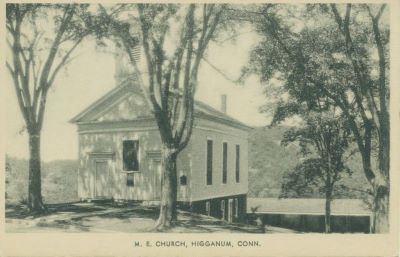 Erected in 1862 this Greek Revival style building stands just north of Haddam Elementary School along Saybrook Road. Methodist circuit riders (traveling preachers) visited Haddam as early as the 1780's and conducted services in the villages and outlying areas. In 1791 the first Methodist Society was organized in the Burr District. Later a Methodist Society was formed in the village center of Haddam and a church built in 1837 along Walkley Hill Road (no longer standing). In Higganum, the Methodists met in the old red schoolhouse until it burned in 1857 and after five years of meeting in private homes built the present church.
Erected in 1862 this Greek Revival style building stands just north of Haddam Elementary School along Saybrook Road. Methodist circuit riders (traveling preachers) visited Haddam as early as the 1780's and conducted services in the villages and outlying areas. In 1791 the first Methodist Society was organized in the Burr District. Later a Methodist Society was formed in the village center of Haddam and a church built in 1837 along Walkley Hill Road (no longer standing). In Higganum, the Methodists met in the old red schoolhouse until it burned in 1857 and after five years of meeting in private homes built the present church.
Higganum Congregational Church
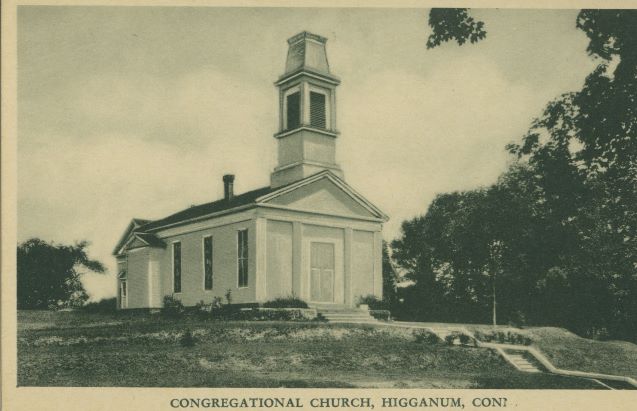 Since Higganum was first settled in the 1670s, residents had to travel to Haddam Center to attend church. In 1844 Higganumites successfully petitioned to form their own ecclesiastical society and took 135 members from the Haddam Congregational Church and their minister, the Reverend David Dudley Field. The church edifice was completed in 1845 and is an excellent example of vernacular Greek Revival architecture. The façade features a fully pedimented gable end topped by a two-stage bell tower. The sanctuary features beautiful stained glass windows from the late 19th century. An addition from 1870 extends from the rear and houses the parish hall, office and kitchen.
Since Higganum was first settled in the 1670s, residents had to travel to Haddam Center to attend church. In 1844 Higganumites successfully petitioned to form their own ecclesiastical society and took 135 members from the Haddam Congregational Church and their minister, the Reverend David Dudley Field. The church edifice was completed in 1845 and is an excellent example of vernacular Greek Revival architecture. The façade features a fully pedimented gable end topped by a two-stage bell tower. The sanctuary features beautiful stained glass windows from the late 19th century. An addition from 1870 extends from the rear and houses the parish hall, office and kitchen.
St. Peter's Roman Catholic Church
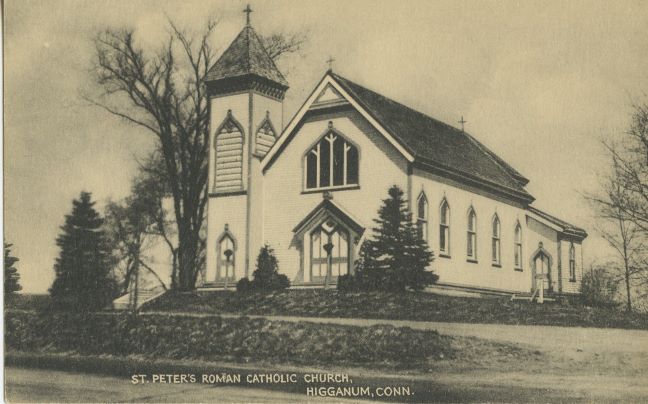 Designed by Owen Brainerd, a Haddam native and architect with Carrere and Hastings in New York, St. Peter's combines the Gothic and Islamic Revival styles to create a fascinating religious edifice. The church was built in 1887 to serve the growing number of Italian and Irish immigrants and descendants drawn to Higganum's factories, including Clark Cutaway Harrow and Scovil Hoe. Prior to erecting the church, Catholics met in private homes or attended St. Joseph's in Chester. This building was sold to private owners provided that it not be used for religious services when in 1960 a new church was built on Maple Avenue.
Designed by Owen Brainerd, a Haddam native and architect with Carrere and Hastings in New York, St. Peter's combines the Gothic and Islamic Revival styles to create a fascinating religious edifice. The church was built in 1887 to serve the growing number of Italian and Irish immigrants and descendants drawn to Higganum's factories, including Clark Cutaway Harrow and Scovil Hoe. Prior to erecting the church, Catholics met in private homes or attended St. Joseph's in Chester. This building was sold to private owners provided that it not be used for religious services when in 1960 a new church was built on Maple Avenue.
St. James Episcopal Church
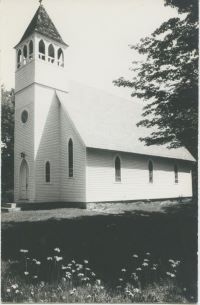 Erected between 1871 and 1873, this Carpenter Gothic style church is located at the intersection of Killingworth and Ponsett roads. Prominent local resident Reverend William Clark Knowles held the first service of the Ponsett Episcopal Church around 1866 following 5 years of providing Sunday School lessons in his home. Reverend Knowles served as pastor of St. James and Killingworth Emmanuel Episcopal churches for 36 years. He died at the age of 92 in 1933. Knowles is also well known for his local history publication "By Gone Days of Ponsett" which was published in 1914.
Erected between 1871 and 1873, this Carpenter Gothic style church is located at the intersection of Killingworth and Ponsett roads. Prominent local resident Reverend William Clark Knowles held the first service of the Ponsett Episcopal Church around 1866 following 5 years of providing Sunday School lessons in his home. Reverend Knowles served as pastor of St. James and Killingworth Emmanuel Episcopal churches for 36 years. He died at the age of 92 in 1933. Knowles is also well known for his local history publication "By Gone Days of Ponsett" which was published in 1914.
St. James Episcopal Church Parish House
The southern portion of the parish house was originally erected as the Ponsett District Schoolhouse.
The First Congregational Church of Haddam
Located in the heart of Haddam Village, the First Congregational Church of Haddam has a long history dating back to the founding of the town.
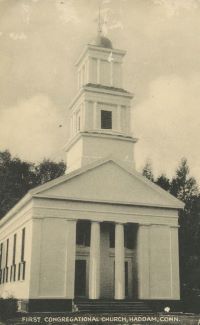 In 1667 services were held in the house built for the minister near the burying ground. A few years later in 1670 the town voted to build a new Meetinghouse measuring 28 x 24 feet and by 1674 construction began. (See Historical Marker - First Meetinghouse) A Meeting House in Colonial America served many different purposes including public worship, church and town meetings, school meetings, courts, legislative assemblies and many other public gatherings. Forty years later a second Meetinghouse was erected between 1718-1721 adjoining the burying yard (30 mile island Plantation Cemetery). The third Meetinghouse was located further to the north along what is now Walkley Hill Road at Meetinghouse Road. This new meetinghouse, much larger is size, measuring 45 x 65 feet, was dedicated in 1771.
In 1667 services were held in the house built for the minister near the burying ground. A few years later in 1670 the town voted to build a new Meetinghouse measuring 28 x 24 feet and by 1674 construction began. (See Historical Marker - First Meetinghouse) A Meeting House in Colonial America served many different purposes including public worship, church and town meetings, school meetings, courts, legislative assemblies and many other public gatherings. Forty years later a second Meetinghouse was erected between 1718-1721 adjoining the burying yard (30 mile island Plantation Cemetery). The third Meetinghouse was located further to the north along what is now Walkley Hill Road at Meetinghouse Road. This new meetinghouse, much larger is size, measuring 45 x 65 feet, was dedicated in 1771.
In 1847 a new church building was erected on the site of the present church, following the division of the congregation into two groups and the founding of the Higganum Congregational Church. The Greek Revival style structure was built by Lloyd E. Baldwin of Willimantic. In 1979 the structure suffered a disastrous fire and was completely destroyed. The present church is a replica of the 1847 building and incorporates some granite blocks from the historic structure.
Old Baptist Church
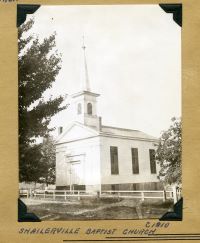 The former Baptist Church of Christ, which was erected in 1833, stands on the east side of Route 154 at the intersection of River Road. This Greek Revival style building replaced an earlier church which stood across the street. In the mid- 18th century a group called "New Lights" or "Separatists" broke away from the established church during the religious revival known as the Great Awakening. The group formed in Haddam was considered a strict Congregational Society and joined with the East Hampton Baptists. The Shailer Family, the predominant family of this area, comprised a large number of the church's membership. The Congregation was active until 1907 when it closed its doors. The building was once more used as a church in 1913 when a former organist asked to be married there. It remained empty for many years and was later converted into a pottery studio. Today it is a private home.
The former Baptist Church of Christ, which was erected in 1833, stands on the east side of Route 154 at the intersection of River Road. This Greek Revival style building replaced an earlier church which stood across the street. In the mid- 18th century a group called "New Lights" or "Separatists" broke away from the established church during the religious revival known as the Great Awakening. The group formed in Haddam was considered a strict Congregational Society and joined with the East Hampton Baptists. The Shailer Family, the predominant family of this area, comprised a large number of the church's membership. The Congregation was active until 1907 when it closed its doors. The building was once more used as a church in 1913 when a former organist asked to be married there. It remained empty for many years and was later converted into a pottery studio. Today it is a private home.
Haddam Neck Congregational Church
This splendid Gothic Revival-style church was erected in 1874 on a bluff overlooking the Connecticut River. It was built with funds left by Edward Davis Clark with the provision that the church be located near the school building (see Haddam Neck Schoolhouse). The builder was A.H. Allen of Portland and the total cost of the building and site was $6000.
 The history of the congregation dates back to 1740 when Haddam Neck residents, tired of having to travel across the river to attend religious services, petitioned the Connecticut General Assembly to establish their own ecclesiastical society. They were joined in this petition by the residents of Middle Haddam, a village of East Hampton, located about 4 miles to the north along the Connecticut River. In 1744 permission was granted and the first church building was erected on Hog Hill about half way between the two communities. This building was later replaced in 1813 by another edifice near Hurd Park. Middle Haddam residents withdrew in 1855 to form their own congregation, while Haddam Neck residents continued to meet in the old church. In 1873 they received the funds to build a new building in Haddam Neck which was built at the foot of School House Hill. The small congregation continues to this day and the church has had little modification except for the removal of the original pipe organ and installation of a barrier-free access ramp.
The history of the congregation dates back to 1740 when Haddam Neck residents, tired of having to travel across the river to attend religious services, petitioned the Connecticut General Assembly to establish their own ecclesiastical society. They were joined in this petition by the residents of Middle Haddam, a village of East Hampton, located about 4 miles to the north along the Connecticut River. In 1744 permission was granted and the first church building was erected on Hog Hill about half way between the two communities. This building was later replaced in 1813 by another edifice near Hurd Park. Middle Haddam residents withdrew in 1855 to form their own congregation, while Haddam Neck residents continued to meet in the old church. In 1873 they received the funds to build a new building in Haddam Neck which was built at the foot of School House Hill. The small congregation continues to this day and the church has had little modification except for the removal of the original pipe organ and installation of a barrier-free access ramp.
